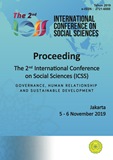HEALTH COMMUNICATION THROUGH ONLINE MEDIA, THE USING OF DIGITAL PREGNANCY APPLICATIONS AS AN ALTERNATIVE INFORMATION SOURCE FOR THE MILLENNIAL MOTHERS IN INDONESIA
Abstract
One of the red report in Indonesia is the high mortality of mothers associated with the process of pregnancy, childbirth, and handling. The condition will be different if people's knowledge about health and pregnancy can be improved, so they are able to perform early detection in a simple way after obtaining essential information that is easily accessible before finally handled by the party Medical. On the other hand, the development of Internet infrastructure in Indonesia is increased, the availability of network that began to facilitate the community in different regions to get access to information according to their needs. Now, the power of communication and information devices can also be used by various circles at a relative affordable cost. Including millennial mothers, also those working mothers and who reside far from the city who often constrained by distance and time to have their pregnancy checked directly to the doctor. Starting from the phenomenon, there are various digital online applications that provide features around health and pregnancy complete with detailed descriptions and interesting visualizations such as The Asian parents, Pregnancy +, Teman Bumil, Halo Bumil, and others. Besides profitable business, the goals of these digital applications are to suppress maternal mortality by raising their awareness to always pay attention to their health condition through the information obtained from the application during pregnancy until post-childbirth. This research explains the phenomenon of the use of pregnancy applications experienced by mothers in Indonesia, how their motives and experiences during the use of health application.Keywords: Health communication, Internet, Millennial mother, Pregnancy digital application.References
Books:
Creswell, (1998). Qualitative Inquiry: Choosing Among Five Tradtions. Sage Publications.
Denzin, N. K. & Lincoln, Y. S. (2011). The SAGE Handbook of Qualitative Research. Fourth Edition. Thousand Oaks, CA: Sage Publication.
Effendy, Onong Uchjana. (1990). Ilmu Komunikasi Teori dan Praktek. Bandung: PT. Remaja Rosda karya.
Kuswarno, Engkus. (2009). Metodologi Penelitian Komunikasi Fenomenologi; Konsepsi, Pedoman, dan Contoh Penelitian, Bandung: Widya Padjajaran
Mubarak dan Chayatin. (2008) Ilmu Kesehatan Masyarakat : Teori dan Aplikasi. Jakarta : Penerbit Salemba Medika.
Notoatmodjo, S. (2005). Promosi Kesehatan: Teori dan Aplikasi. Jakarta : Rineka Cipta.
Patton, Michael Quinn. (2002). Qualitative Research and Evaluation Methods. USA: Sage Publicatin Inc.
Steven Schwartz, S. (2000). Abnormal Psychology: a discovery approach. California: Mayfield Publishing Company.
Wicaksono, I. E.(2016). Kompetensi Komunikasi Antarbudaya dalam Konteks Tempat Kerja. Tesis. Universitas Indonesia.
Journals:
Baxter, L., Nichole E., Ho, Evelyn. (2008). Everyday Health Communication Experiences. Journal of American College Health. Vol. 56 No. 4.
Rahmadiana, Metta. (2012). Komunikasi Kesehatan: Sebuah Tinjauan. Jurnal Psikogenesis. Vol. 1 No. 1
Rahman, Abd. (2015). Hubungan Pengetahuan dan Sikap Ibu Hamil dalam Mengenal Tanda Bahaya Kehamilan dan Persalinan di Puskesmas Managaisaki. Jurnal Kesehatan Tadulako Vol. 1 No. 2, Hal. 1- 78
Websites:
http://www.depkes.go.id/resources/download/pusdatin/profil-kesehatan-indonesia/Data-dan-Informasi_Profil-Kesehatan-Indonesia-2018.pdf, latest access at 15 September 2019, 09.22 WIB
https://www.viva.co.id/gaya-hidup/kesehatan-intim/1129180-lima-isu-kesehatan-prioritas-kemenkes-dalam-5-tahun-ke-depan, latest access at 20 September 2019, 12.02 WIB.
https://www.who.int/en/news-room/fact-sheets/detail/newborns-reducing-mortality,latest access at 22 September 2019, 02.00 WIB


